| Physics 202 |
Intro to Astronomy: Lecture #22
|
Prof. Dale E. Gary
NJIT
|
The Milky Way Galaxy
Overview of the Milky
Way Galaxy
Our Sun is but one
of 100 billion stars that make up our galaxy. We can see the nearby
stars all around us on any night, but the number of stars visible with
the naked eye is only about 2000 stars. On really clear nights in
dark spots far from city lights, you can also see the faint trace across
the sky of the Milky Way, as shown in the picture below:
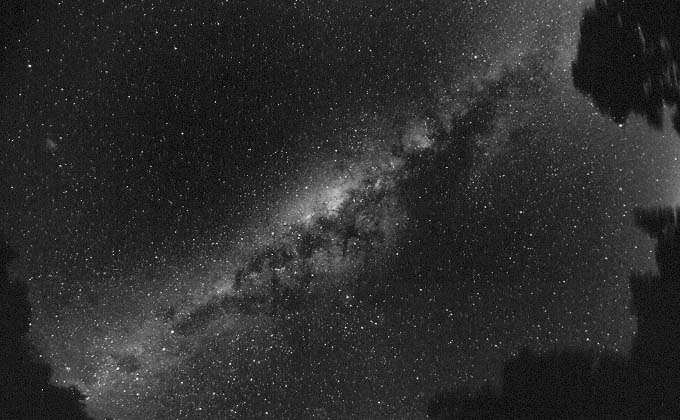 There are so many distant stars
that they mingle together to form a faint glow. Here is a picture
through a telescope that gives you an idea of the number of stars in just
one small area of the Milky Way:
There are so many distant stars
that they mingle together to form a faint glow. Here is a picture
through a telescope that gives you an idea of the number of stars in just
one small area of the Milky Way:
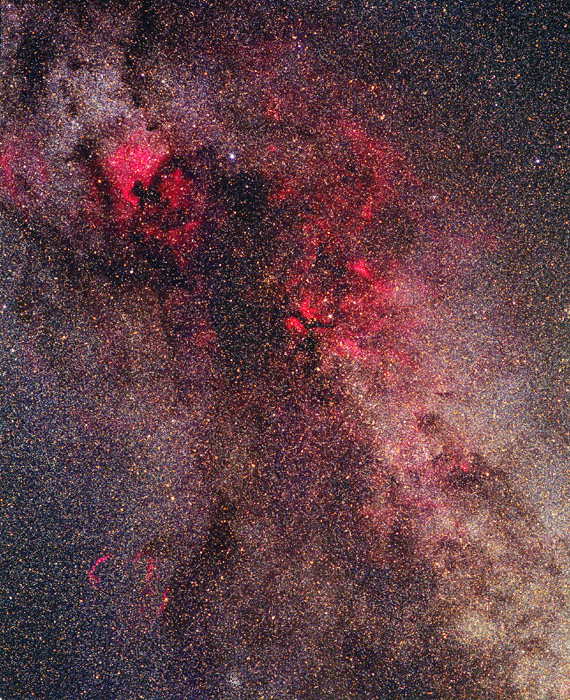 As we discussed before, you
can also see dust clouds that obscure stars. These are the clouds
in which new generations of stars are being born.
As we discussed before, you
can also see dust clouds that obscure stars. These are the clouds
in which new generations of stars are being born.
We cannot see the Milky Way
from outside, of course, but we know that it is a barred spiral galaxy and so we know that it has the same features as other spirals:
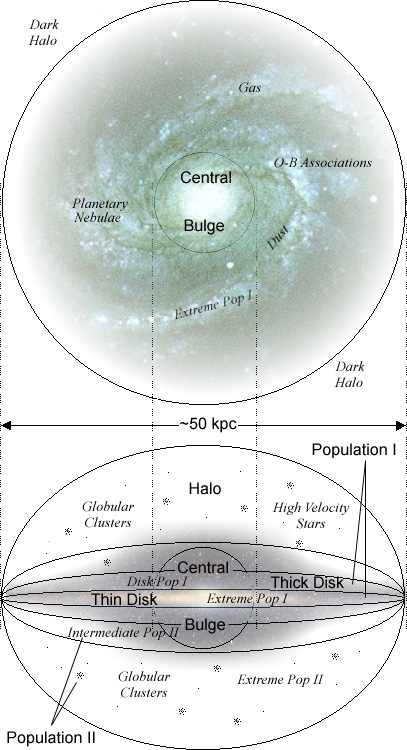
Here is an actual picture
of the Milky Way, taken from space in the infra-red (so that we can see
through the dust and gas that normally obscures parts of the galaxy:
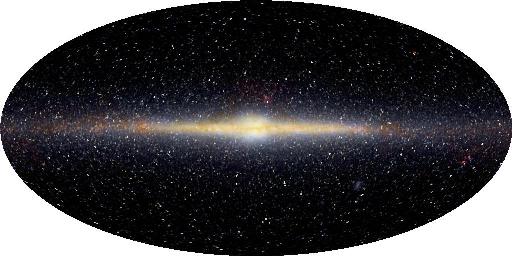
Image of the Milky Way Galaxy
taken with the COBE
satellite.
In this image, you can see the
central
bulge, the disk, and faintly,
the dust. You can see that the disk is bright in the plane, and fades out as you go up or down from it. For comparison, here is a picture of another edge-on spiral galaxy:
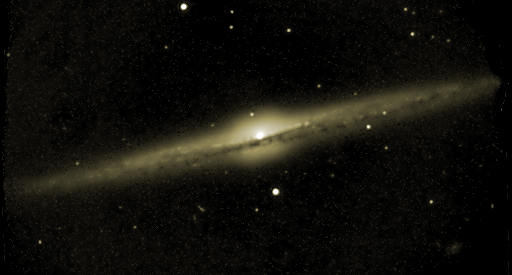
If we could see the galaxy from above, we would see spiral
arms, as in this image:
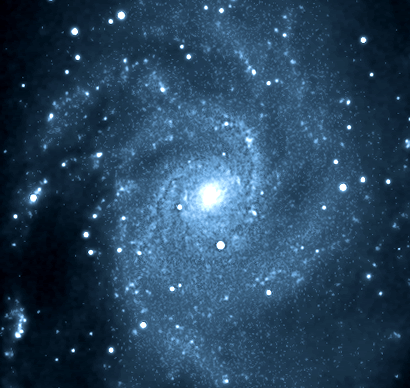
We find that the stars
in different parts of the plane of the galaxy are somewhat different --
the stars in the plane are younger. Notice the dust is very close
to the plane, and that is where stars are born. We will discuss in
a later lecture why the stars are older in the thicker disk, and in the
bulge, but it is basically because stars are no longer being born in those
locations.
The Milky Way galaxy has
two nearby companions, or satellite galaxies, called the Magellanic Clouds,
which can only be seen from the southern hemisphere of Earth. Here
is a picture of the Milky Way and the Magellanic Clouds, along with a close-up
of the satellite galaxies themselves:
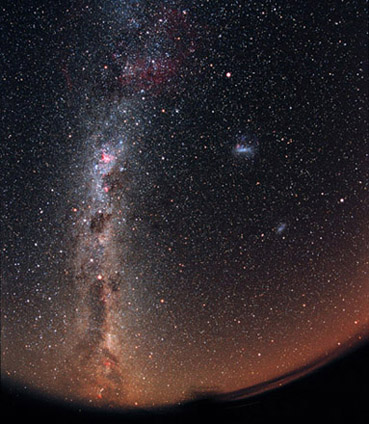 -
-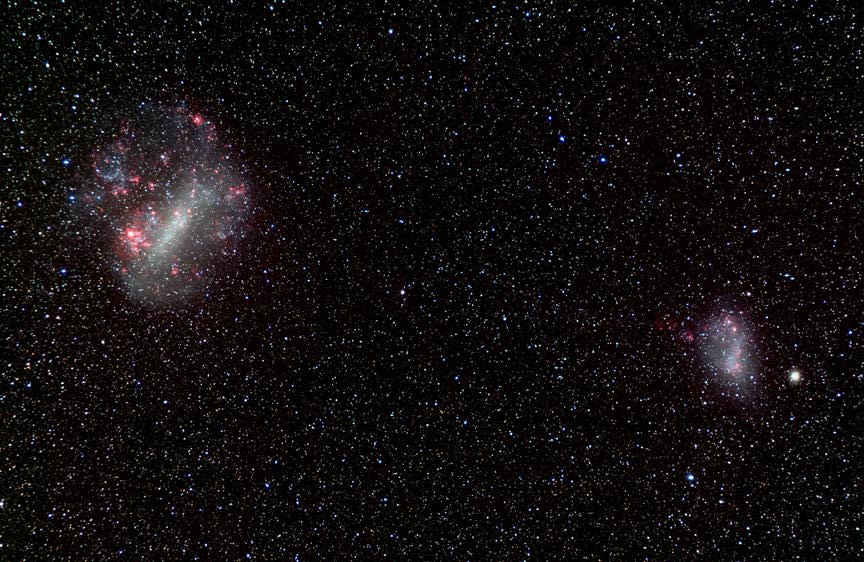
The Star-Gas-Star Cycle
We saw how stars
are formed out of gas and dust clouds of the interstellar
medium. We also saw how stars lose a lot of their mass
back into the interstellar medium when they die, either because they enter
a planetary nebula phase and gently lose their outer layers, or they blow
up in a supernova explosion. We also saw that stars make heavier
elements from lighter ones through nuclear fusion, which produces the energy
to make the stars shine. Generations of stars are continually being
born and die, and as they do so they encorporate material from the interstellar
medium, enrich it with heavier elements, and then send it back into the
interstellar medium. This process is called chemical
enrichment, and over time the abundance of heavier elements
in the universe increases.
The hot material
in a supernova explosion is ejected at 10,000 km/s or more. If it
were not for the interstellar medium, this matter would continue to move
straight out of the galaxy and never stop. But because there is gas and
dust everywhere, the matter eventually slows and comes to a stop, most
before it gets out of the galaxy. There it intermingles with the
hydrogen gas, but before it can become a star it has to cool down.
It cools by colliding with dust grains, and the dust then radiates its
heat away in the infra-red. The gas first cools enough to form atomic
hydrogen, then it cools further until the hydrogen forms molecular hydrogen
(H2). It takes millions of years
for this cooling to occur. Once the matter is in the form of molecular
clouds, gravity can take over and the cloud will collapse, starting the
entire process again.
Let's examine life at the
edge of a molecular cloud. This process we will discuss is dominated
by the highest mass stars, because they live such a short time (only 10-100
million years). Say we start with a molecular cloud whose temperature
is low enough to allow collapse of parts of it. The stars that are
formed from it have all sizes, with a relatively few being high-mass stars.
Those stars start shining very brightly, with lots of UV radiation, which
burns a hole in that region of the cloud where they are born.

Trapezium stars of the Orion Nebula (Orion Molecular Cloud).
In the image above, you can
see a few very bright stars (the Trapezium stars) that have just recently
formed from the Orion Molecular Cloud. This kind of grouping is called
an O-B Association. There are
several tear-drop-shaped objects around them that are protostars just being
born. Because the Trapezium stars are so massive, they will burn
out in 10 million years or so and go supernova. At that time, their
outer layers will explode outward and run into the surrounding molecular
cloud, forming shock waves that can trigger more cloud collapses.
The other stars nearby will be largely unaffected, and will form a star
cluster. The new collapse will produce more O and B stars, which
will repeat the process, eating into the cloud from one end until the entire
cloud has gone through a collapse. There will thus be a chain of
older stars at one end and younger ones at the other. The older stars
will disperse over a billion or so years, as their slightly different speeds
make the cluster slowly separate. Widely separated stars that are
all moving in the same direction are called a moving
group. Many of the
stars of the Big Dipper form a moving group. Here is what the dipper looked like in the past, and will look like in the future:

Superbubbles and Fountains
 -
-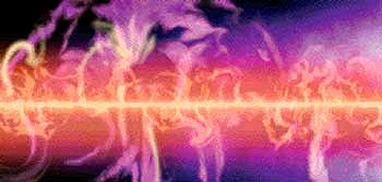
When we look closely at the
hydrogen clouds of the Milky Way, we see that some gas clouds are well
outside the disk (figure above left), and these clouds are generally hot
gas. It is thought that these may be galactic supernova fountains,
as sketched in the figure above right. These are due to O-B Associations
that form multiple supernovas. The parts of the explosions that are
in the plane of the disk do not go very far because of the interstellar
medium, but those parts directed upward or downward out of the plane of
the galaxy have nothing to run into, so they keep going. Eventually,
the disk gravity turns them around again, and they fall back into the disk.
How do we detect these clouds?
Some we can see directly, of course, because they block the light of stars
if they have enough dust. Others are mostly gas (either ionized hydrogen,
atomic hydrogen, or molecular hydrogen). We can detect all three
kinds of gas through the kinds of radiation they produce. Ionized
hydrogen is the easiest, because it radiates visible and UV light in the
form of spectral lines. The electrons associated with ionized hydrogen
also radiate X-rays. Atomic hydrogen radiates mainly at a particular
radio wavelength, called the 21-cm line. Molecular clouds, including
hydrogen but also CO and other molecules, radiate in the mm-wavelength
radio range. The dust, of course, radiates mostly in the IR.
Here
is a view of the Milky Way in various wavelengths.
Milky Way in Motion
We saw how planets
orbit the Sun, with the inner planets orbiting faster than the outer planets.
The planetary orbits behave according to the mass of the Sun, concentrated
in the center of the solar system. Stars orbiting the galaxy behave
in a similar way, except note that the mass is distributed,
and is not concentrated in the center of the galaxy. This means that
orbits are modified somewhat. Stars out of the plane of the galaxy
orbit at an angle relative to that plane. Stars in the disk orbit
in the disk, but they may have a kind of bobbing motion, because as the
start to move up out of the disk, the preponderance of stars below it in
the disk cause it to slow down and start to move down into the disk again,
etc.
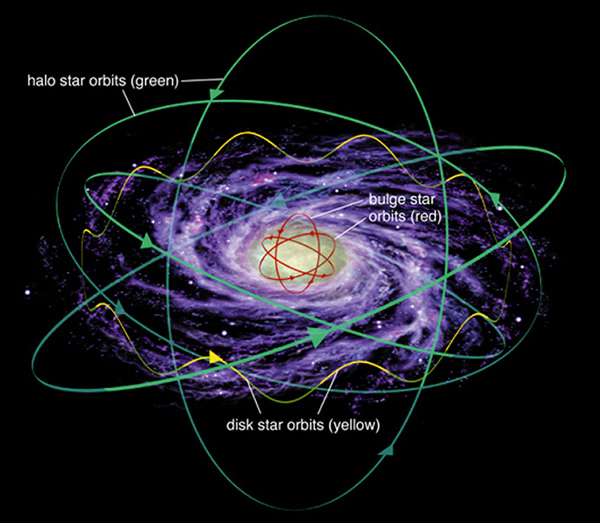
Galactic rotation and orbital
speeds:
See the tutorial
on detecting dark matter in spiral galaxies. This tutorial will
help you see that the orbital speeds of stars in the galaxy are a clue
to the total mass of the galaxy. What we find, to our surprise, is
that the amount and distribution of mass appears to be completely different
from the amount and distribution of luminous matter. There is a need
for a vast amount of dark matter to
explain the orbits seen in the galaxy. We do not know what this matter
is, but we know that it is not like ordinary matter, which should be detectable
at some wavelength. Somehow it can remain hidden. We will investigate
this dark matter in a later lecture. Dark matter is one of the greatest
mysteries in astronomy today.
Spiral Arms:
The spiral arms of our galaxy
and others are not very well understood. It is believed that they
are some form of density wave. Imagine star orbits that line up as
shown below:

You can see that the stars
will orbit longer and congregate in regions where the orbits are close
together. These orbits amount to density
waves, like traffic congestion. The individual stars do
not travel in the wave, but rather the wave is a place where the stars
bunch up for a time, while they go in their separate paths.
The Galactic Center:
The center of our galaxy
is in the constellation Sagittarius. It contains a radio and X-ray
source called Sagittarius-A, or Sag-A, which is thought to be due to a
supermassive black hole. Recently, the case for a black hole at the
center of the galaxy appears to have been proven, due to the very fast
orbit of a star very near the galactic center. Here is an older report
and movie of these inner stars. The latest
news (2002 Oct 18) is that the central object must be a black hole.





 -
-


 -
-

